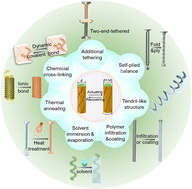Tethering of twisted-fiber artificial muscles
Abstract
Twisted-fiber artificial muscles, a new type of soft actuator, exhibit significant potential for use in applications related to lightweight smart devices and soft robotics. Fiber twisting generates internal torque and a spiral architecture, exhibiting rotation, contraction, or elongation as a result of fiber volume change. Untethering a twisted fiber often results in fiber untwisting and loss of stored torque energy. Preserving the torque in twisted fibers during actuation is necessary to realize a reversible and stable artificial muscle performance; this is a key issue that has not yet been systematically discussed and reviewed. This review summarizes the mechanisms for preserving the torque within twisted fibers and the potential applications of such systems. The potential challenges and future directions of research related to twisted-fiber artificial muscles are also discussed.



 Please wait while we load your content...
Please wait while we load your content...